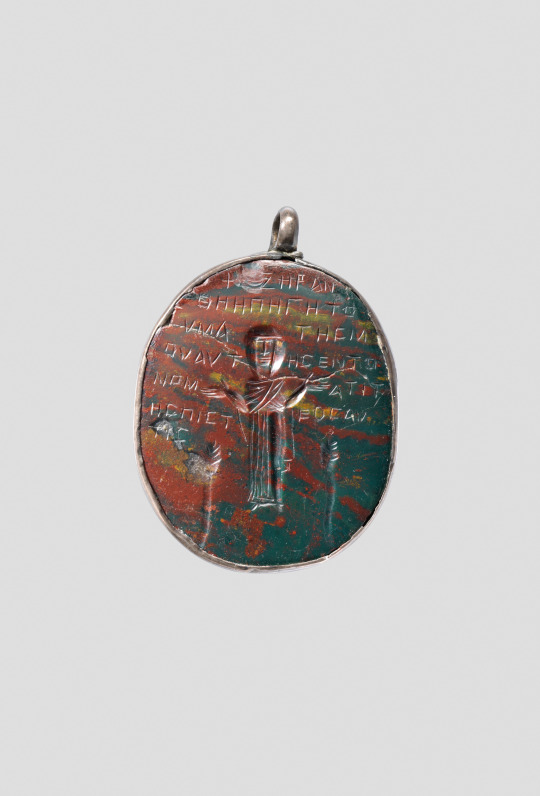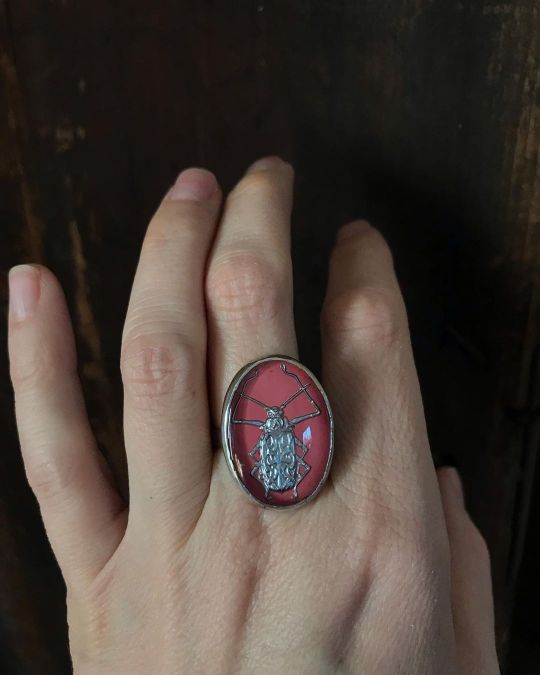#reverse intaglio
Explore tagged Tumblr posts
Text

Circa Early 19th Century Reverse Intaglio Of Medusa In Rock Crystal Surrounded by 3.00 Carats Of Diamonds, Mounted In 18k White Gold by French Jeweler, Marc Auclerf
Photo Courtesy: Dmitry Kostyukov for The New York Times
Source: nytimes.com
#marc auclerf#medusa#intaglio#reverse intaglio#rock crystal#diamonds#18k white gold#diamond halo jewelry#rock crystal and diamond jewelry#antique rock crystal jewelry#high jewelry#luxury jewelry#fine jewelry#fine jewellery pieces#gemville
63 notes
·
View notes
Text

Reverse Intaglio Cat in Crystal Cabachon
1 note
·
View note
Text


Amulet Carved in Intaglio (Incised)
Byzantine (Egypt), 6th–7th century CE
Inscriptions identify the subject of this amulet as the Woman with the Issue of Blood (Mark 5:25–34; Luke 8:43–48). On the reverse a woman stands in the orant (prayer) pose. Hematite was believed to stop the flow of blood and was a favorite medium for amulets related to female reproductive health and menstrual problems.
174 notes
·
View notes
Text

A pair of Victorian reverse painted crystal intaglio earrings, 1870.
21 notes
·
View notes
Photo

A Pair of Victorian Reverse Painted Crystal Intaglio Earrings, 1870
10 notes
·
View notes
Text
Signets and Seals
Seals and signets are devices that leave an impression in some type of soft material, such as wax and clay. They were used to prevent tampering and authentication of items and letters. These seals could be made of metal or stone called the matrix as they would hold the designs. Most of the early seals were cut into the surface, a process called intaglio, so the design is raised on the surface, called a relief. The design will appear reversed on the surface, which is a consideration especially when writing is part of the seal.

By This file was donated to Wikimedia Commons as part of a project by the Metropolitan Museum of Art. See the Image and Data Resources Open Access Policy, CC0, https://commons.wikimedia.org/w/index.php?curid=61209631
The earliest known seals were from the 6th millennium BCE among the Halaf culture who existed from about 6100 BCE to 5100 BCE, but given their complexity, they probably existed earlier. Something similar was used among the Indus Valley Civilization in the mid- to late-3rd millennium BCE. These stamps were replaced with cylinder seals among the Mesopotamian cultures of Sumer and those who lived in and expanded those areas.

By Aoineko - Own work, CC BY-SA 1.0, https://commons.wikimedia.org/w/index.php?curid=47172
In ancient Egypt, signet rings were the form of choice for their seals beginning approximately 2000 BCE. These rings carried the weight of authority with the wearing of them, so these rings were worn by the ruling class. These signet rings were made of metal and typically had the person's name or the Pharaoh's cartouche, an oval with a line at one end and generally contained the praenomen, or throne name, which was one of the five royal names, with their title around the cartouche. This ring was typically worn on the little finger of the non-dominant hand. Some of these rings had swiveling faces with a different design on the opposite side.

source: https://www.britishmuseum.org/collection/object/G_1891-0806-86
The use of signet rings continued with the Greek peoples in about the 6th century BCE, beginning with soft stones and ivory until rotary carving (or drill-type carving) developed, when they shifted to hard stones and gems. Many of the motifs of these rings were based in nature or mythology rather than the name of the person. These rings seemed to be simple adornments rather than identification, as they were among the Egyptians. They were also collected, especially among the rich, and were worn on the little finger. This continued into the Roman society as well.

source: https://www.xzmuseum.com/ecollection_detail.aspx?id=2235
Seals have been used in East Asia since the Qin dynasty (221 BCE). They were used as a form of written identification, establishing their identity. Until the Tang dynasty, they were used to make impressions in clay. Beginning with the Tang dynasty (618 CE), a particular ink made from cinnabar began to be used instead. These are made of hard materials like bronze, soap stone, and jade. There is some evidence of something like a seal, characters on cast bronze vessels from the Shang dynasty (1600-1046 BCE), indicate they might be far older than their widespread use. These seals weren't (and aren't) worn. They often have animals, either mythical or real, on the opposite side. Chinese seals are often square with the person's name on it.
2 notes
·
View notes
Text

Poseidon Neptune Glass Intaglio Pendant Reverse Carved Silver Tone Necklace by PastSplendors http://dlvr.it/T8KdrW
4 notes
·
View notes
Text

Welcome Back (2023) edition of 6 intaglio etching
---
Another print featuring Bluebell Littleears! literally 3/4 projects from this class are bluebell-centric lmao you can really tell I had her on the mind
Had a lot of fun with the textures and stuff... I think I should've reversed it made the darker part the foreground not the background lol but alas!
I actually quite enjoyed doing etchings! They weren't as well liked by the ppl in my class, and I hate the smell lol but I LOVED the part where you're gently wiping the ink off with tarlatan I really got a good feel for it it was great... I love lil repetitive task hehe
(posting all this stuff on this blog is making me realize I have another piece titled welcome back tho lol whoops)
some process photos:


digital sketch

2 notes
·
View notes
Photo

Pocket watch fob seal used by a gentleman with nautical background, c. 1820
This is a gilt metal seal, which has a lozenge shaped base set with a red hardstone. The stone is exquisitely engraved with an intaglio of a sailing ship in rough seas with the words “Such is life” in reverse.
#naval artifacts#pocket watch fob seal#gentleman's accessoire#used by a merchant ship owner or captain#or by a navy officer#early 19th century#age of sail
61 notes
·
View notes
Text

Reverse Carved Pendant Poseidon Neptune Glass Intaglio Silver Tone Necklace by PastSplendors http://dlvr.it/T2lZ7x
2 notes
·
View notes
Text


Processional Cross, Spanish, ca. 1150–75 (x)
This cross conveys the luxury found within churches that dotted the Christian kingdoms of northern Spain during the Middle Ages. It comes from a twelfth-century church fifty miles east of Oviedo, once the capital of the kingdom of Asturias. The cross shows a crowned, crucified Jesus flanked on the cross’ arms by the Virgin Mary and Saint John. An angel appears at the top, as Adam rises from his grave at the bottom. A rock crystal above Jesus’ head covers a cavity that still holds an unidentified relic. Gilded filigree bars attached to each of the arms of the cross served as settings for an array of gems, including antique intaglios. Only two remain—one showing an ancient figure of Victory, and the other a male nude with a fish and spear—both prized embellishments suitable for a sumptuous object. A Latin inscription on the reverse reads: “In honor of the Holy Savior: Sanccia [Sancha] Guidisalvi had me made.” The feminine ending of Sanccia indicates that the donor, or possibly the goldsmith, was a woman.
2 notes
·
View notes
Photo

Vintage beetle cab ring 🖤 Reverse intaglio cab from before 1950 featuring a beetle ~ set in sterling silver ~ size 8 #vintagecab #vintagecabochons #intaglio #reverseintaglio #beetle #beetlejuice #beetlejuicebeetlejuicebeetlejuice #entomology #rings #metalsmith #jewelersofinstagram #statementring #pink https://www.instagram.com/p/CqdVU0fOdEl/?igshid=NGJjMDIxMWI=
#vintagecab#vintagecabochons#intaglio#reverseintaglio#beetle#beetlejuice#beetlejuicebeetlejuicebeetlejuice#entomology#rings#metalsmith#jewelersofinstagram#statementring#pink
7 notes
·
View notes
Text

a pair of victorian reverse painted crystal intaglio earpendants from 1870
5 notes
·
View notes
Photo
Cylinder seals are cylindrical objects carved in reverse (intaglio) in order to leave raised impressions when rolled into clay. Seals were generally used to mark ownership, and they could act as official identifiers, like a signature, for individuals and institutions. A seal’s owner rolled impressions in wet clay to secure property such as baskets, letters, jars, and even rooms and buildings. This clay sealing prevented tampering because it had to be broken in order to access a safeguarded item. Cylinder seals were often made of durable material, usually stone, and most were drilled lengthwise so they could be strung and worn. A seal’s material and the images inscribed on the seal itself could be protective. The artistry and design might be appreciated and considered decorative as well. Cylinder seals were produced in the Near East beginning in the fourth millennium BCE and date to every period through the end of the first millennium BCE.
-
Mesopotamia, 3000-2700 B.C.
Tools and Equipment; seals
Black marble
-
This seal illustrates a scene with the goddess Ishtar welcoming a devotee. A cuneiform inscription is incorporated into the scene.



Cylinder seals of the ancient Near East
Invented in southern Mesopotamia (modern Iraq) about 3500 BC, cylinder seals were used as magical amulets, administrative tools, and jewellery. These small cylinders had a design carved in intaglio, and a hole through them, enabling them to be worn on string.
When these seals were rolled onto clay, a continuous impression was left of the design. Shown here are three such examples of these impressions, with the cylinder seal itself alongside the second example. The first example dates to 800-600 BC (Neo-Elamite), the second is the oldest at 3000-2700 BC, and the third, ca. 700 BC (Achaemenid).
The Walters provides the following description for the first example:
In the 8th and 7th centuries BC, Elam, to the east of Mesopotamia in Iran, experienced a brief period of prosperity during which it allied itself with Babylonia against Assyria. The seals produced in Elam during this period reflect themes derived from Mesopotamia, such as the lion hunt seen here; however, the strong modeling, the almost decorative patterning of the details, and the exaggerated posture of the lion characterize the local Elamite style.
Cylinder Seal with a Lion Hunt, courtesy of the Walters Art Museum, Baltimore: 42.797.
Cylinder Seal, courtesy of the LACMA: M.71.73.11c.
Cylinder Seal with Ishtar Welcoming a Devotee, courtesy of the Walters Art Museum, Baltimore: 42.782.
#history#art#art history#economics#trade#commerce#jewellery#languages#neo-elamite period#mesopotamia#elam#achaemenid empire#babylonia#neo-babylonian empire#neo-assyrian empire#iraq#iran#ishtar#cylinder seals#marble#cuneiform#cylinder seal ref
813 notes
·
View notes
Photo

Antique Gold Edwardian Filigree Fob Chain Bracelet With Reverse Intaglio Of A Horse, Gold Horse Fob and Gold Saddle Charm
0 notes
Text

Poseidon Neptune Glass Intaglio Pendant Reverse Carved Silver Tone Necklace Marine Life Water Sea Theme by PastSplendors http://dlvr.it/TFSbXv
1 note
·
View note